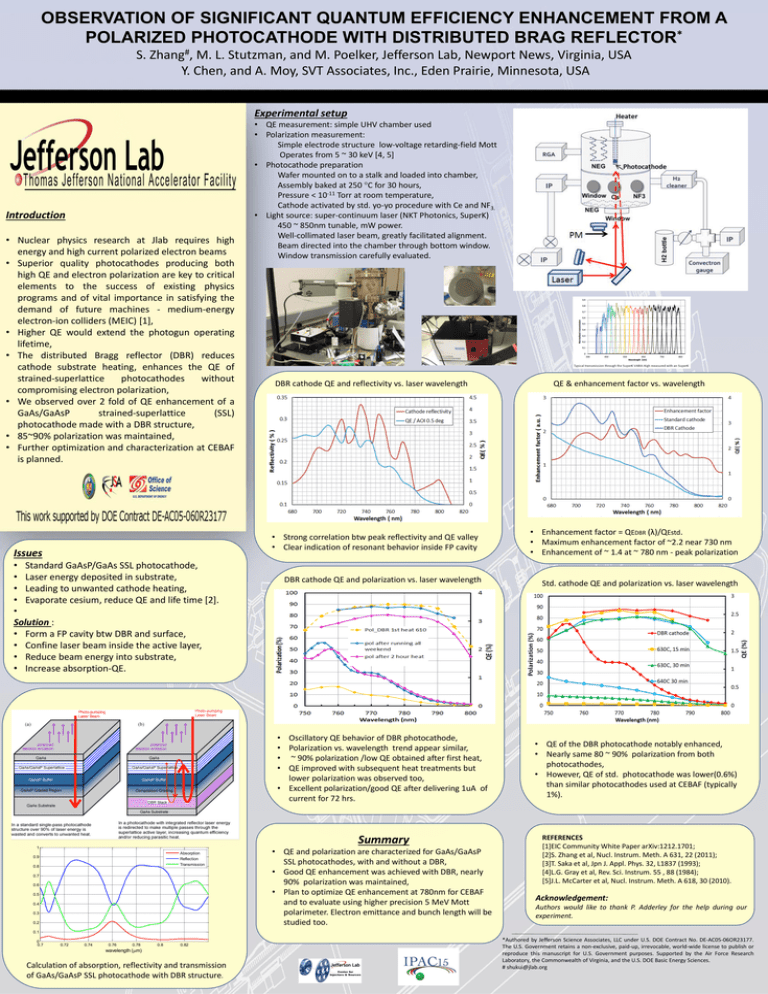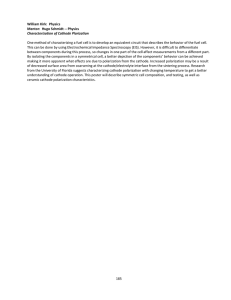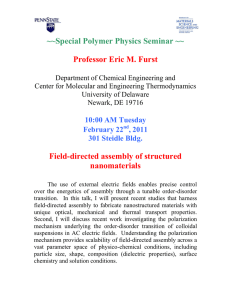observation of significant quantum efficiency
advertisement

OBSERVATION OF SIGNIFICANT QUANTUM EFFICIENCY ENHANCEMENT FROM A * POLARIZED PHOTOCATHODE WITH DISTRIBUTED BRAG REFLECTOR S. # Zhang , M. L. Stutzman, and M. Poelker, Jefferson Lab, Newport News, Virginia, USA Y. Chen, and A. Moy, SVT Associates, Inc., Eden Prairie, Minnesota, USA Experimental setup Introduction • Nuclear physics research at Jlab requires high energy and high current polarized electron beams • Superior quality photocathodes producing both high QE and electron polarization are key to critical elements to the success of existing physics programs and of vital importance in satisfying the demand of future machines - medium-energy electron-ion colliders (MEIC) [1], • Higher QE would extend the photogun operating lifetime, • The distributed Bragg reflector (DBR) reduces cathode substrate heating, enhances the QE of strained-superlattice photocathodes without compromising electron polarization, • We observed over 2 fold of QE enhancement of a GaAs/GaAsP strained-superlattice (SSL) photocathode made with a DBR structure, • 85~90% polarization was maintained, • Further optimization and characterization at CEBAF is planned. DBR cathode QE and reflectivity vs. laser wavelength • Strong correlation btw peak reflectivity and QE valley • Clear indication of resonant behavior inside FP cavity Issues • • • • • QE measurement: simple UHV chamber used • Polarization measurement: Simple electrode structure low-voltage retarding-field Mott Operates from 5 ~ 30 keV [4, 5] • Photocathode preparation Wafer mounted on to a stalk and loaded into chamber, Assembly baked at 250 C for 30 hours, Pressure < 10-11 Torr at room temperature, Cathode activated by std. yo-yo procedure with Ce and NF3. • Light source: super-continuum laser (NKT Photonics, SuperK) 450 ~ 850nm tunable, mW power. Well-collimated laser beam, greatly facilitated alignment. Beam directed into the chamber through bottom window. Window transmission carefully evaluated. Standard GaAsP/GaAs SSL photocathode, Laser energy deposited in substrate, Leading to unwanted cathode heating, Evaporate cesium, reduce QE and life time [2]. DBR cathode QE and polarization vs. laser wavelength QE & enhancement factor vs. wavelength • Enhancement factor = QEDBR (λ)/QEstd. • Maximum enhancement factor of ~2.2 near 730 nm • Enhancement of ~ 1.4 at ~ 780 nm - peak polarization Std. cathode QE and polarization vs. laser wavelength • Solution : • Form a FP cavity btw DBR and surface, • Confine laser beam inside the active layer, • Reduce beam energy into substrate, • Increase absorption-QE. • Oscillatory QE behavior of DBR photocathode, • Polarization vs. wavelength trend appear similar, • ~ 90% polarization /low QE obtained after first heat, • QE improved with subsequent heat treatments but lower polarization was observed too, • Excellent polarization/good QE after delivering 1uA of current for 72 hrs. Summary 1 Absorption Reflection Transmission 0.9 0.8 0.7 0.6 0.5 0.4 0.3 0.2 • QE and polarization are characterized for GaAs/GaAsP SSL photocathodes, with and without a DBR, • Good QE enhancement was achieved with DBR, nearly 90% polarization was maintained, • Plan to optimize QE enhancement at 780nm for CEBAF and to evaluate using higher precision 5 MeV Mott polarimeter. Electron emittance and bunch length will be studied too. • QE of the DBR photocathode notably enhanced, • Nearly same 80 ~ 90% polarization from both photocathodes, • However, QE of std. photocathode was lower(0.6%) than similar photocathodes used at CEBAF (typically 1%). REFERENCES [1]EIC Community White Paper arXiv:1212.1701; [2]S. Zhang et al, Nucl. Instrum. Meth. A 631, 22 (2011); [3]T. Saka et al, Jpn J. Appl. Phys. 32, L1837 (1993); [4]L.G. Gray et al, Rev. Sci. Instrum. 55 , 88 (1984); [5]J.L. McCarter et al, Nucl. Instrum. Meth. A 618, 30 (2010). Acknowledgement: Authors would like to thank P. Adderley for the help during our experiment. 0.1 0 0.7 0.72 0.74 0.76 0.78 0.8 0.82 wavelength (m) Calculation of absorption, reflectivity and transmission of GaAs/GaAsP SSL photocathode with DBR structure. *Authored by Jefferson Science Associates, LLC under U.S. DOE Contract No. DE-AC05-06OR23177. The U.S. Government retains a non-exclusive, paid-up, irrevocable, world-wide license to publish or reproduce this manuscript for U.S. Government purposes. Supported by the Air Force Research Laboratory, the Commonwealth of Virginia, and the U.S. DOE Basic Energy Sciences. # shukui@jlab.org




